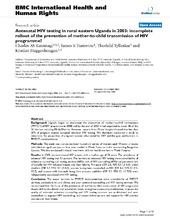| dc.description.abstract | Background: Uganda began to implement the prevention of mother-to-child transmission (PMTCT) of HIV programme in 2000, and by the end of 2003 it had expanded to cover 38 of the 56 districts including Mbale District. However, reports from Mbale Hospital showed that less than 10% of pregnant women accepted antenatal HIV testing. We therefore conducted a study to determine the proportion of pregnant women who tested for HIV and the gaps and barriers in PMTCT implementation. Methods: The study was a cross sectional household survey of women aged 18 years or more, with children aged one year or less, who resided in Mbale Town or in the surrounding Bungokho County. We also conducted in-depth interviews with six health workers in Mbale Hospital. Results: In 2003, we interviewed 457 women with a median age of 24 years. The prevalence of antenatal HIV testing was 10 percent. The barriers to antenatal HIV testing were unavailability of voluntary counselling and testing services (44%), lack of HIV counselling (42%) and perceived lack of benefits for HIV infected women and their infants. Primipara (OR 2.6, 95% CI 1.2–5.8), urban dwellers (OR 2.7, 95% CI 1.3–5.8), women having been counselled on HIV (OR 6.2, 95% CI 2.9–13.2), and women with husbands being their primary confidant (OR 2.3, 95% CI 1.0–5.5) were independently associated with HIV testing. Conclusion: The major barriers to PMTCT implementation were unavailability of PMTCT services, particularly in rural clinics, and poor antenatal counselling and HIV testing services. We recommend that the focus of the prevention of mother-to-child transmission of HIV programme should shift to the district and sub-district levels, strengthen community mobilization, improve the quality of antenatal voluntary counselling and HIV testing services, use professional and peer counsellors to augment HIV counselling, and ensure follow-up care and support for HIV positive women and their infants. | en_US |

